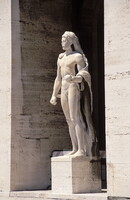EUR: Palazzo della Civiltà Italiana
Pagano, Giuseppe; Piacentini, Marcello

Download1A3-FA-EUR-2-H5_cp.jpg (472.3Kb)
Alternative Titles
Palazzo della Civiltà del Lavoro
Colosseo Quadrato
Date
1938-1943Description
Sculpture, under the plinth level arches (statues symbolize the arts, sciences and industry), frontal view, northwest corner; The Palazzo della Civiltà Italiana was constructed as part of the program of the Esposizione Universale Roma, now a large business center and suburban complex, initiated in 1935 by Benito Mussolini for the planned 1942 world exhibition and as a symbol of fascism for the world. The Palazzo was designed by the architects Giovanni Guerrini, Ernesto Bruno La Padula and Mario Romano and constructed constructed between 1938 and 1943. It was inaugurated on 30 November 1940 as the centerpiece of the Esposizione and continues to be its most iconic building. The structure is also considered one of the most representative examples of Fascist architecture at the EUR. At the four corners of the podium are placed four equestrian sculptural groups by Publio Morbiducci and Alberto de Felci, representing the Dioscuri, the two mythical Greek heroes Castor and Pollux, sons of Zeus and Leda. About the base of the building are 28 additional statues of approximately 3.4 meters in height, each under an arch, illustrating various industries and trades. These statues were added in 1942 Source: Wikipedia; http://en.wikipedia.org/wiki/Main_Page (accessed 2/1/2008)
Type of Work
exhibition building; office buildingSubject
architectural exteriors, cityscapes, rulers and leaders, Esposizione universale di Roma (1942 : Rome, Italy), Fascism, Novecento italiano, Modernist
Rights
Rights Statement
Licensed for educational and research use by the MIT community only